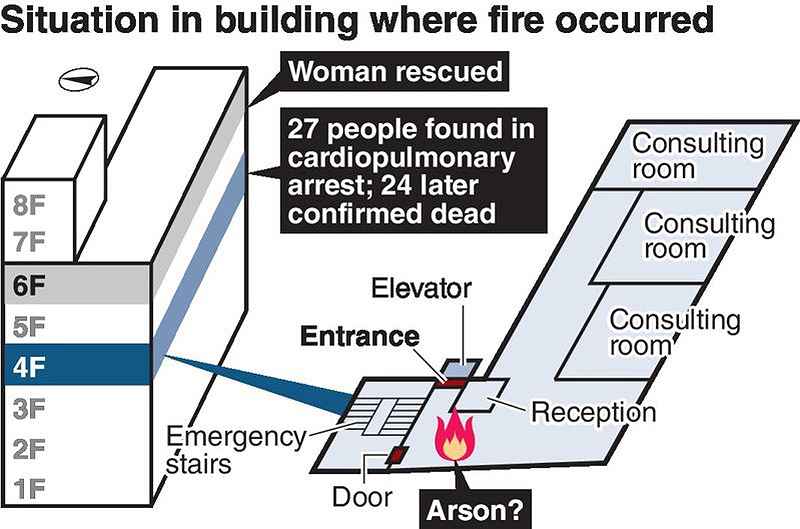
17:37 JST, December 18, 2021
OSAKA — The suspected arson attack on a building in central Osaka on Friday was a catastrophe that killed more than 20 people. After past building fires that caused mass casualties, preventive measures were reinforced each time. The latest case raises questions over why the fatalities could not be prevented despite such measures, calling for a prompt investigation.
Exit cut off
“The fire burned intensely for a short period of time, and the burned area was limited. I’m shocked at the consequences of so many people being killed because they couldn’t escape,” a senior official of the Osaka prefectural police said Friday afternoon.
The building is an eight-story reinforced concrete structure. Its fourth floor houses only the Nishi-Umeda Kokoro to Karada no Clinic, where the incident took place. Patients usually used the clinic’s entrance, directly connected to the building’s elevator. The building has only one staircase, also near the entrance. It is believed that patients and clinic staff in consulting rooms at the back of the building may not have been able to escape because the fire broke out near the entrance.
According to a man who had visited the psychosomatic clinic, the waiting area near the reception desk was usually crowded with about 20 patients, and there were often people who could not find seats.
Building predates revised law
Were there any legal problems with the building?
The Osaka city government conducts on-site inspections every four years. According to the Osaka Municipal Fire Department, the building was equipped with legally required devices — fire extinguishers, guide lights and an automatic fire alarm system — when a regular inspection was conducted in March 2019.
No sprinklers had been installed as the building was not subject to regulations on them. Multitenant buildings meeting certain conditions, such as having at least 3,000 square meters of floor area, are required to install sprinklers.
Ensuring at least two evacuation routes is considered important to prevent casualties in a fire, but the building has only one staircase. A man is suspected to have started the fire near the clinic’s entrance, so it is likely that people at the clinic could not reach the staircase to evacuate.
The Building Standards Law requires large buildings to have at least two staircases leading to the ground to prevent an evacuation route from being completely cut off by flames and smoke. This regulation applies to buildings with six or more floors in principle, regardless of the buildings’ use or floor area.
However, according to the Land, Infrastructure, Transport and Tourism Ministry, this regulation was added when the law was revised in 1974. As the Osaka building was constructed four years before the law revision, it is not subject to the regulation.
Even if the fire started near the only staircase, evacuation through the clinic’s windows might have been theoretically possible. However, it was not immediately known whether the clinic had a ladder or other evacuation equipment. Even if the clinic did have such equipment, quick evacuation still would not have been easy.
Regulations don’t assume arson
Most of the victims in the fire are believed to have died of carbon monoxide poisoning.
Carbon monoxide and other toxic gases generated in a fire can fill a small room in a few tens of seconds, causing people to lose consciousness in a single breath, according to Takao Sakaguchi, a former chief of the Azabu Fire Station in Tokyo. Sakaguchi, 74, now serves on the board of the citizen’s disaster prevention research institute, a public interest incorporated body in Tokyo.
At the clinic, the area near the ceiling was burned, and concrete was exposed.
“Although the fire was contained in about 30 minutes, the burning was intense,” Sakaguchi said. He noted that the clinic could have filled with carbon monoxide before people even had a chance to open the windows.
Tokyo University of Science Prof. Ichiro Hagiwara, 61, who specializes in fire safety engineering, said, “Basically, the Fire Service Law and the Building Standards Law do not assume a case in which a fire spreads all at once by arson, so there is a limit to what can be done by legal regulations alone.”
“It is necessary to consider measures to enhance safety, such as by lowering fire insurance premiums for buildings that have taken measures stronger than those required by law,” he added.
"Society" POPULAR ARTICLE
-

M4.9 Earthquake Hits Tokyo, Neighboring Prefectures
-

Israeli Tourists Refused Accommodation at Hotel in Japan’s Nagano Pref., Prompting Protest by Israeli Embassy and Probe by Prefecture
-

M7.5 Earthquake Hits Northern Japan; Tsunami Waves Observed in Hokkaido, Aomori and Iwate Prefectures
-

Tsukiji Market Urges Tourists to Avoid Visiting in Year-End
-

High School in Kyoto Says Students Shoplifted during Recent School Trip to Bali, Indonesia
JN ACCESS RANKING
-

Tokyo Economic Security Forum to Hold Inaugural Meeting Amid Tense Global Environment
-

Keidanren Chairman Yoshinobu Tsutsui Visits Kashiwazaki-Kariwa Nuclear Power Plant; Inspects New Emergency Safety System
-

Imports of Rare Earths from China Facing Delays, May Be Caused by Deterioration of Japan-China Relations
-

University of Tokyo Professor Discusses Japanese Economic Security in Interview Ahead of Forum
-

Japan Pulls out of Vietnam Nuclear Project, Complicating Hanoi’s Power Plans

























